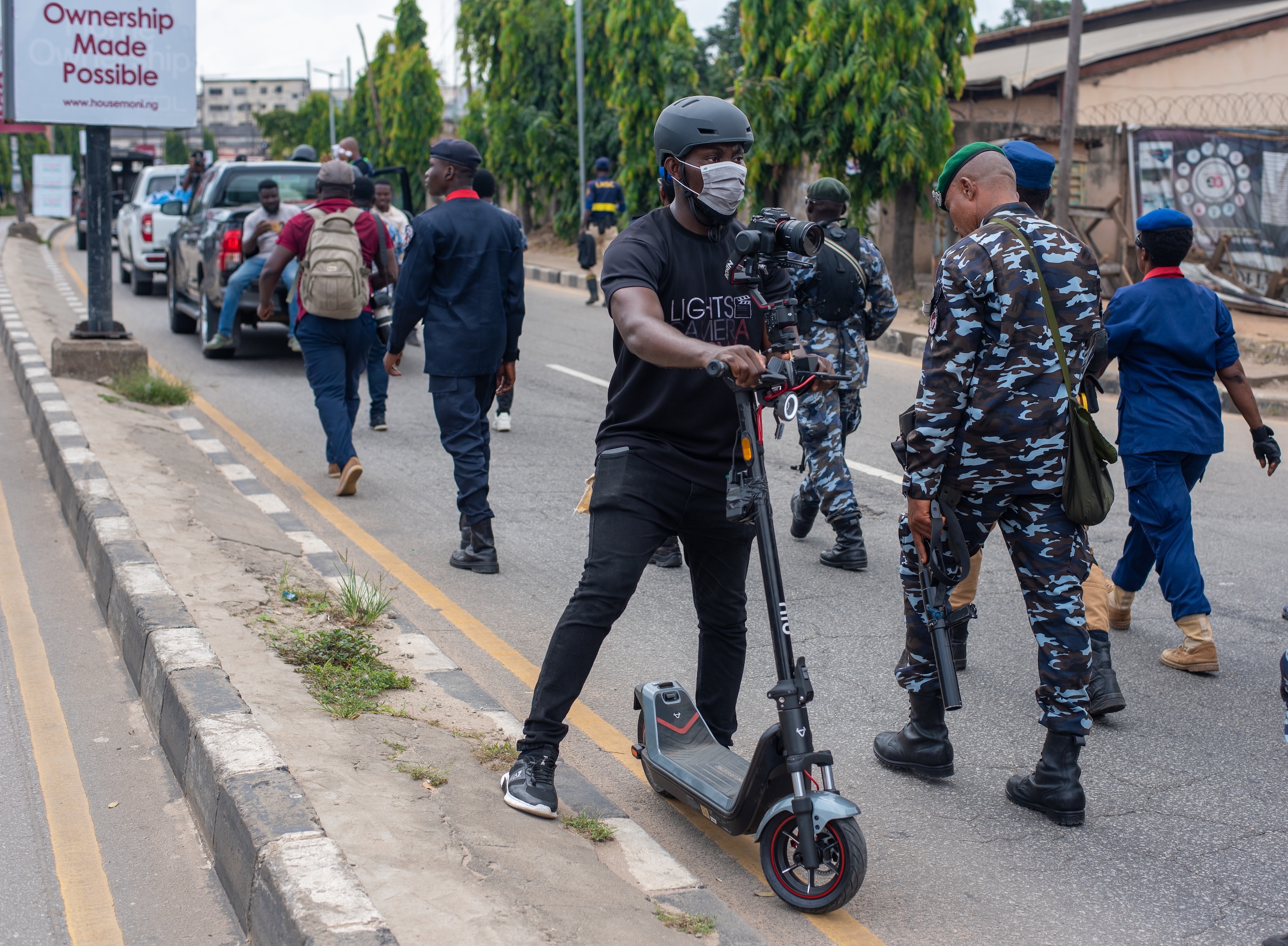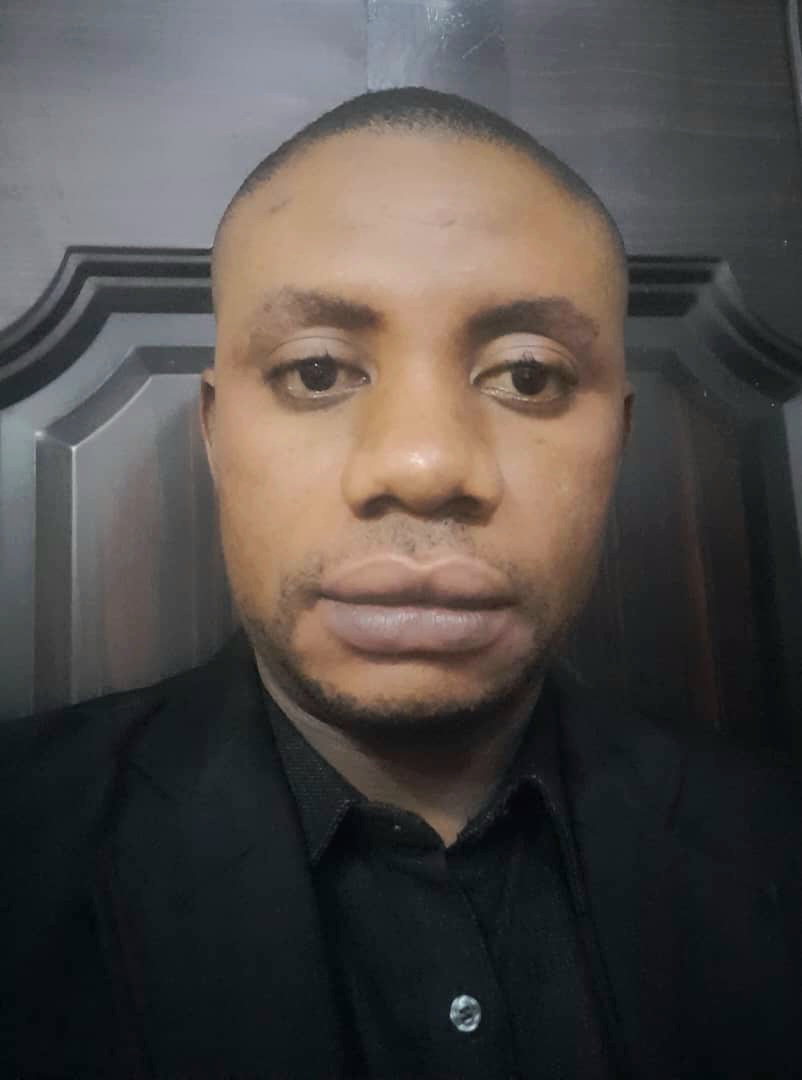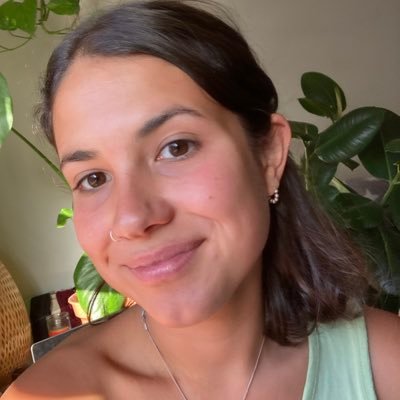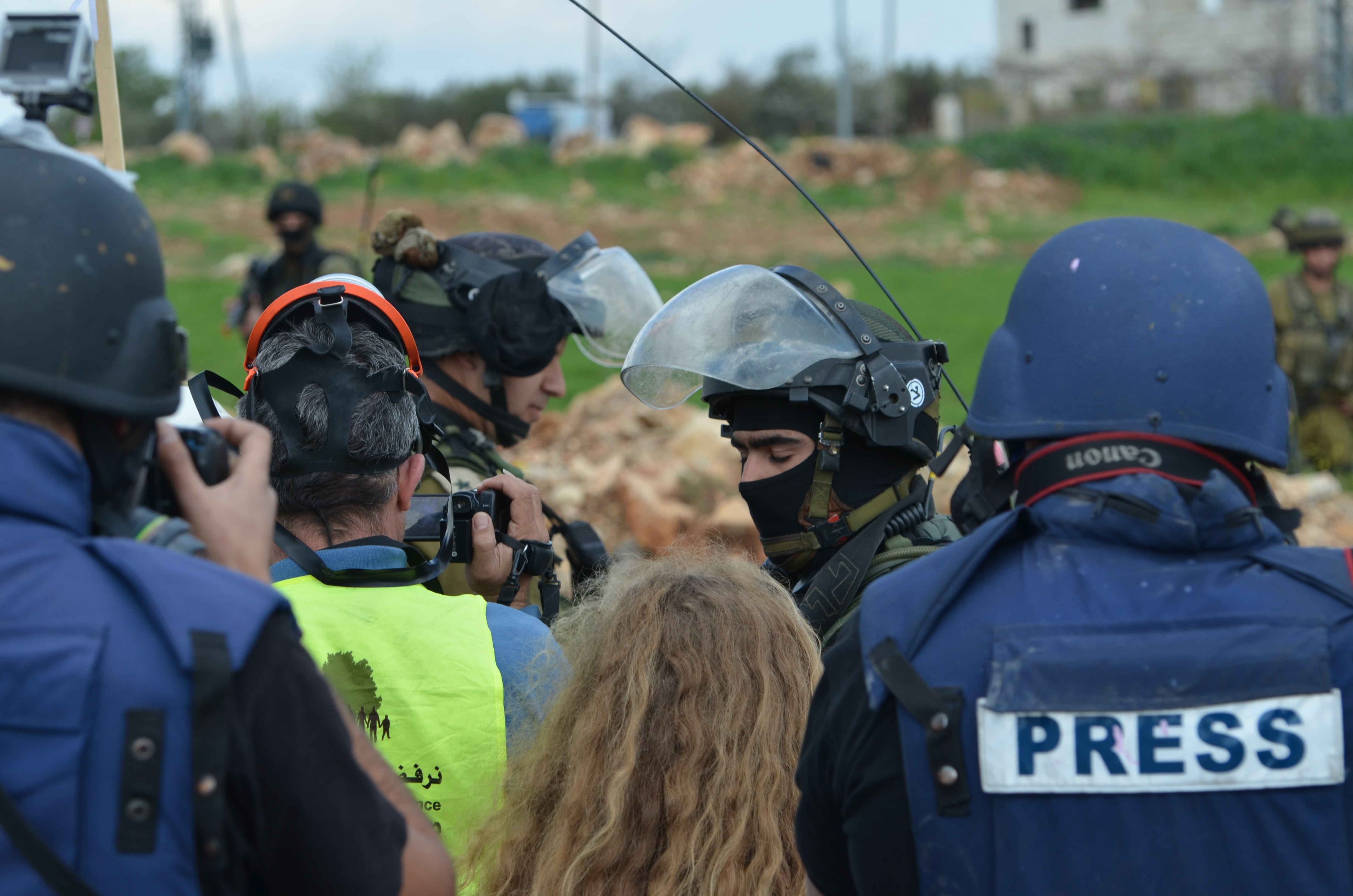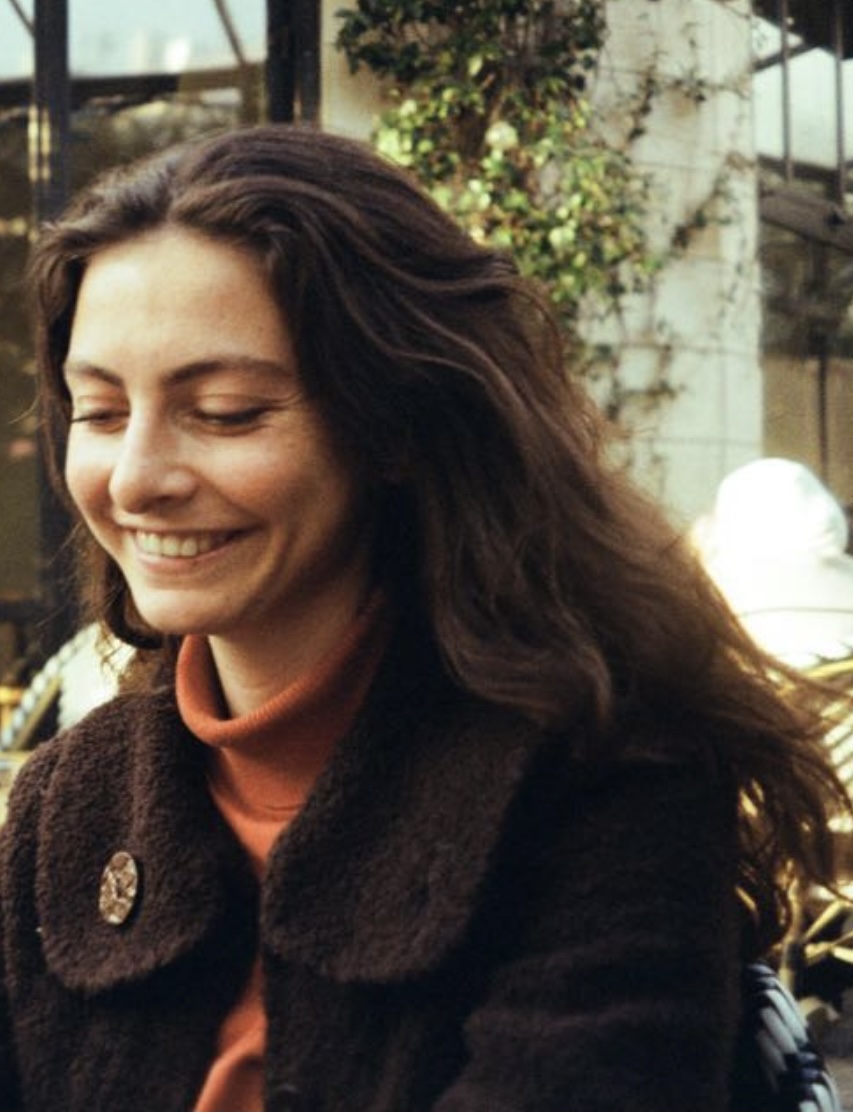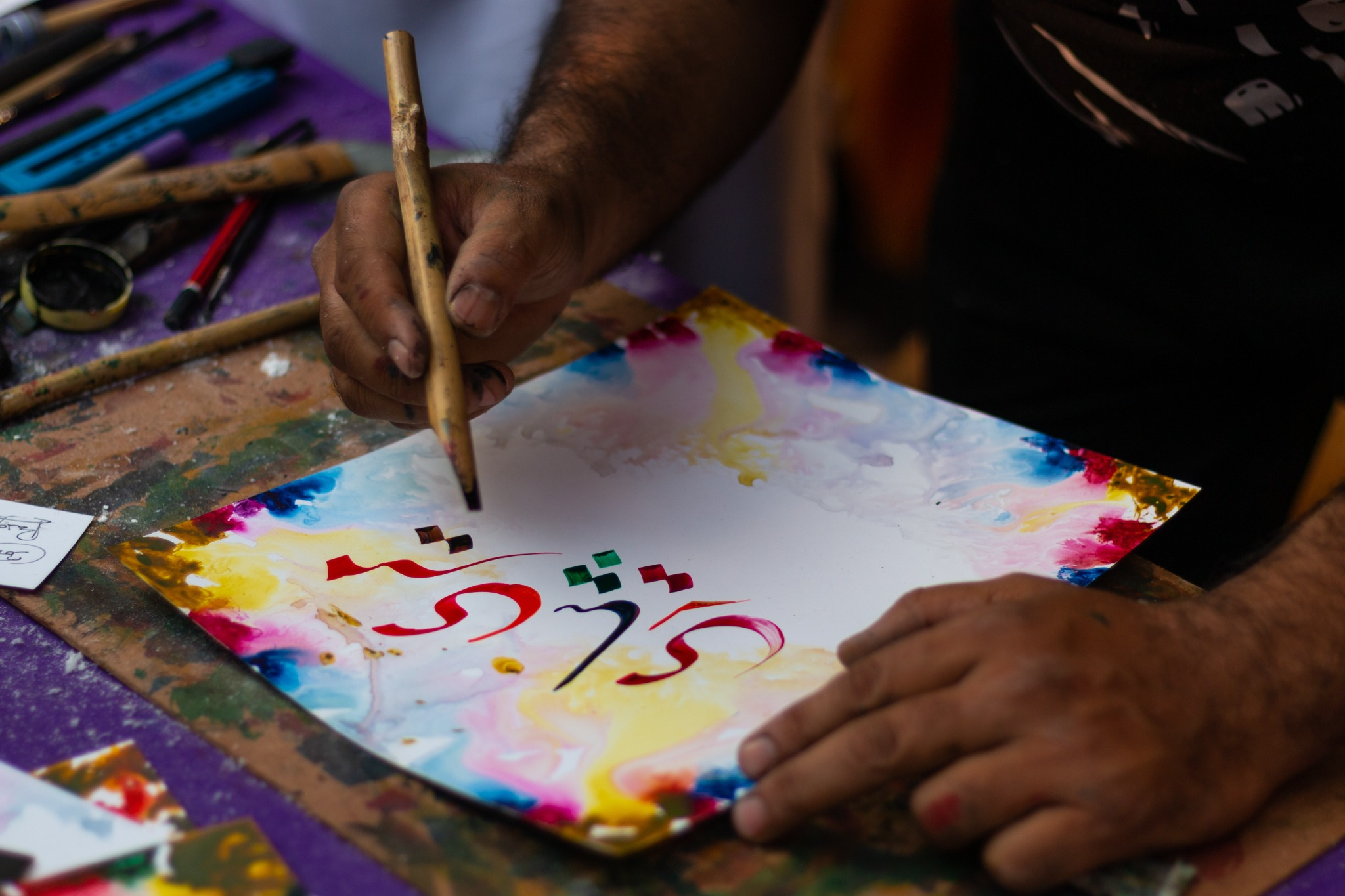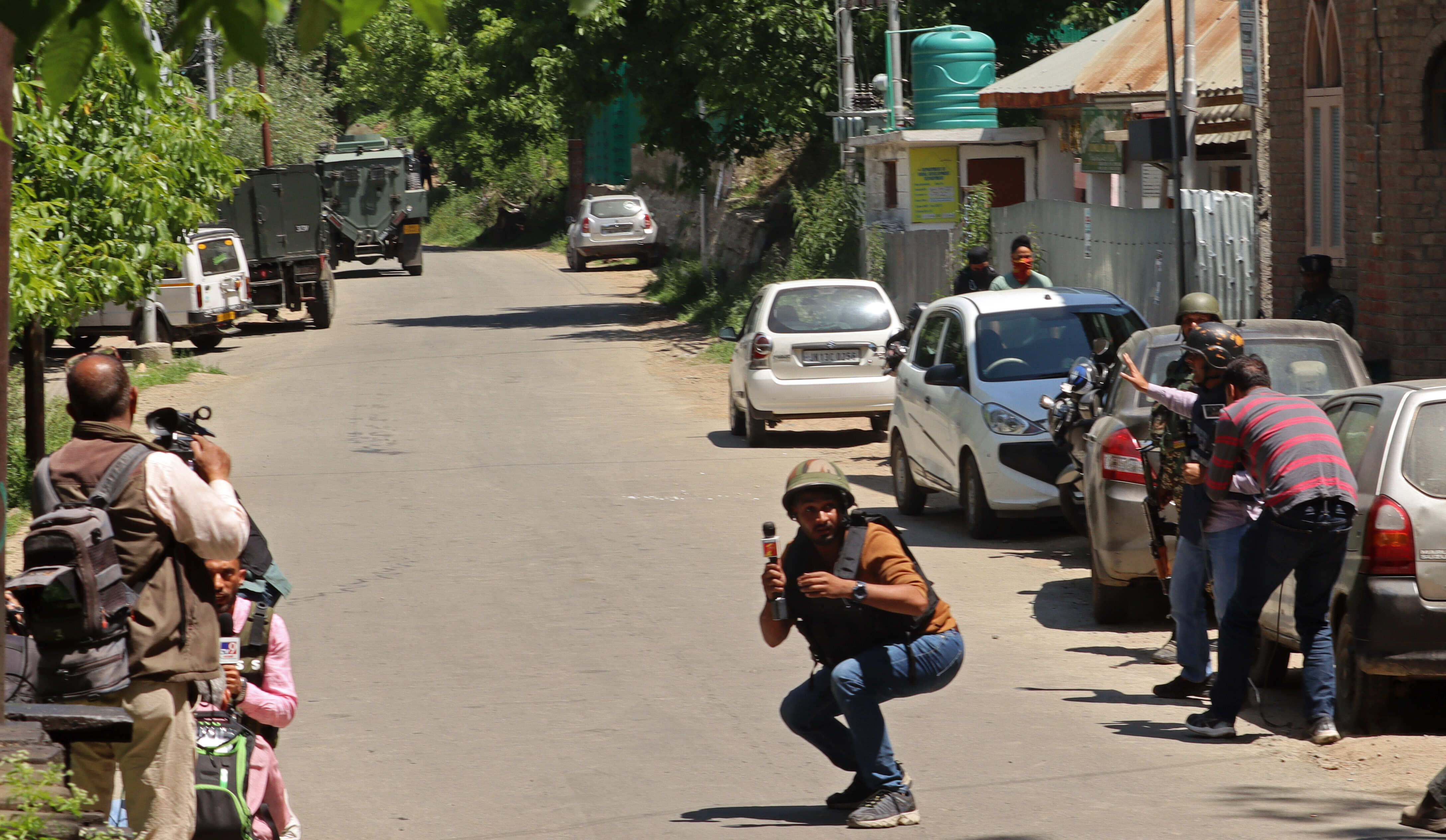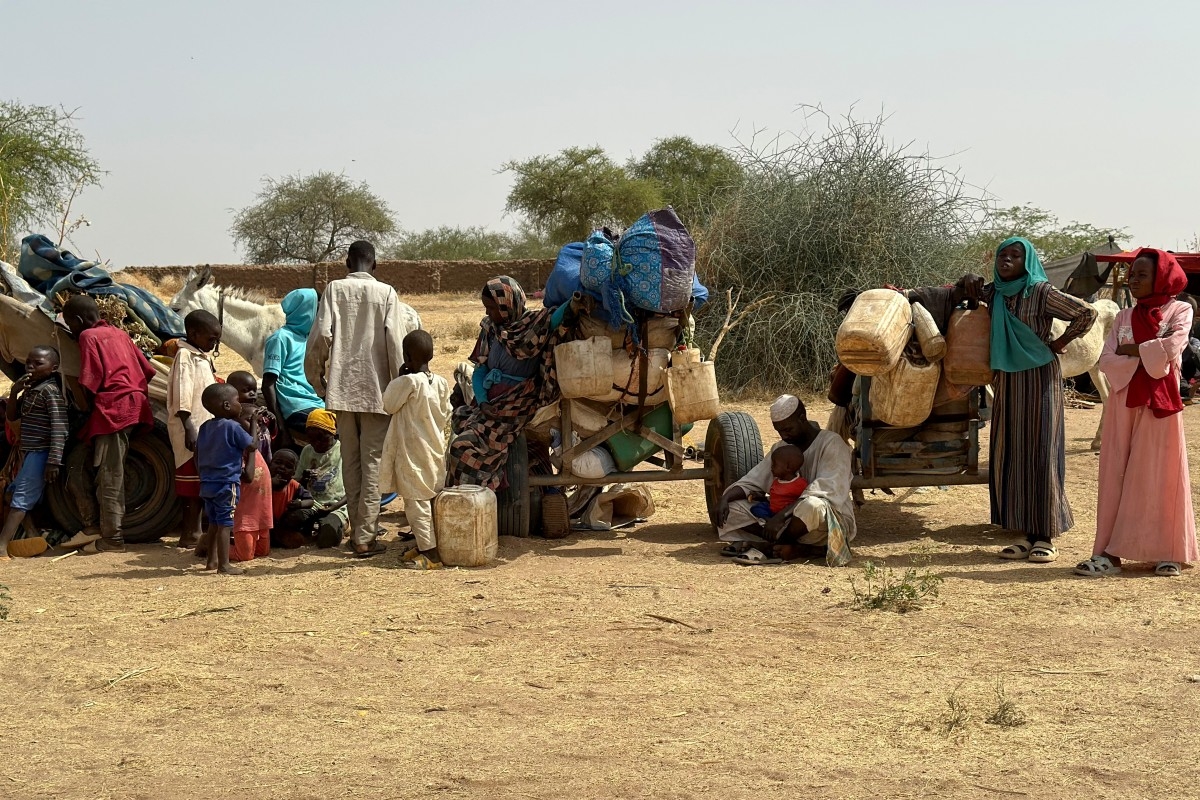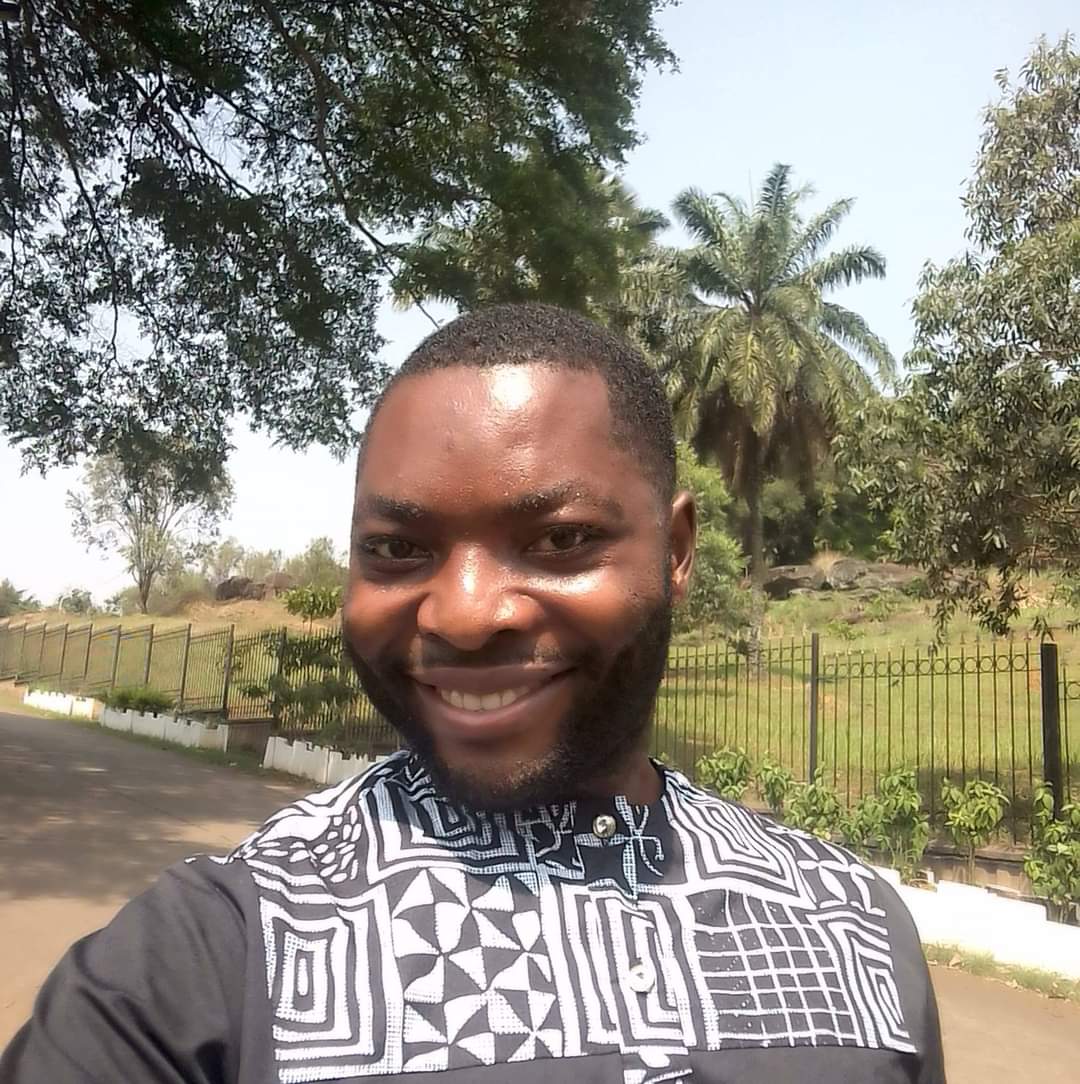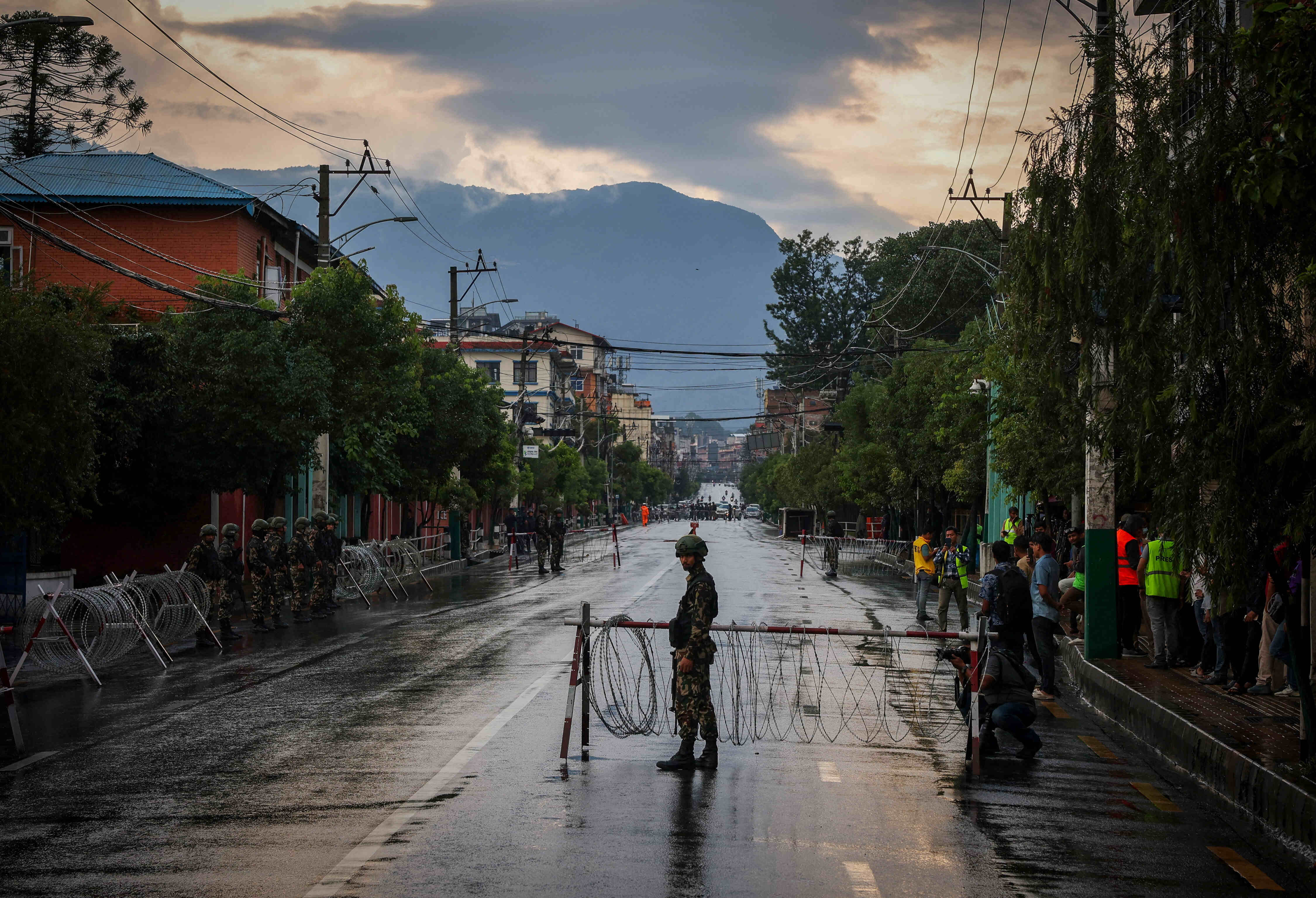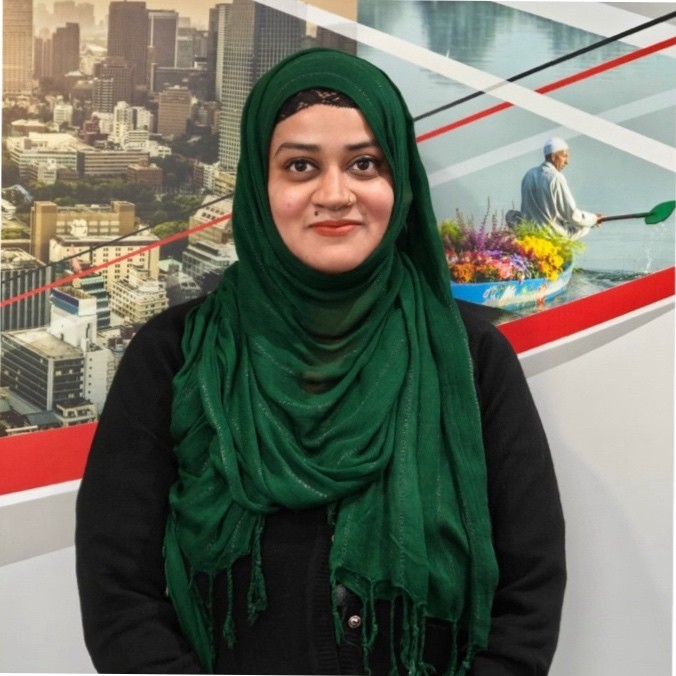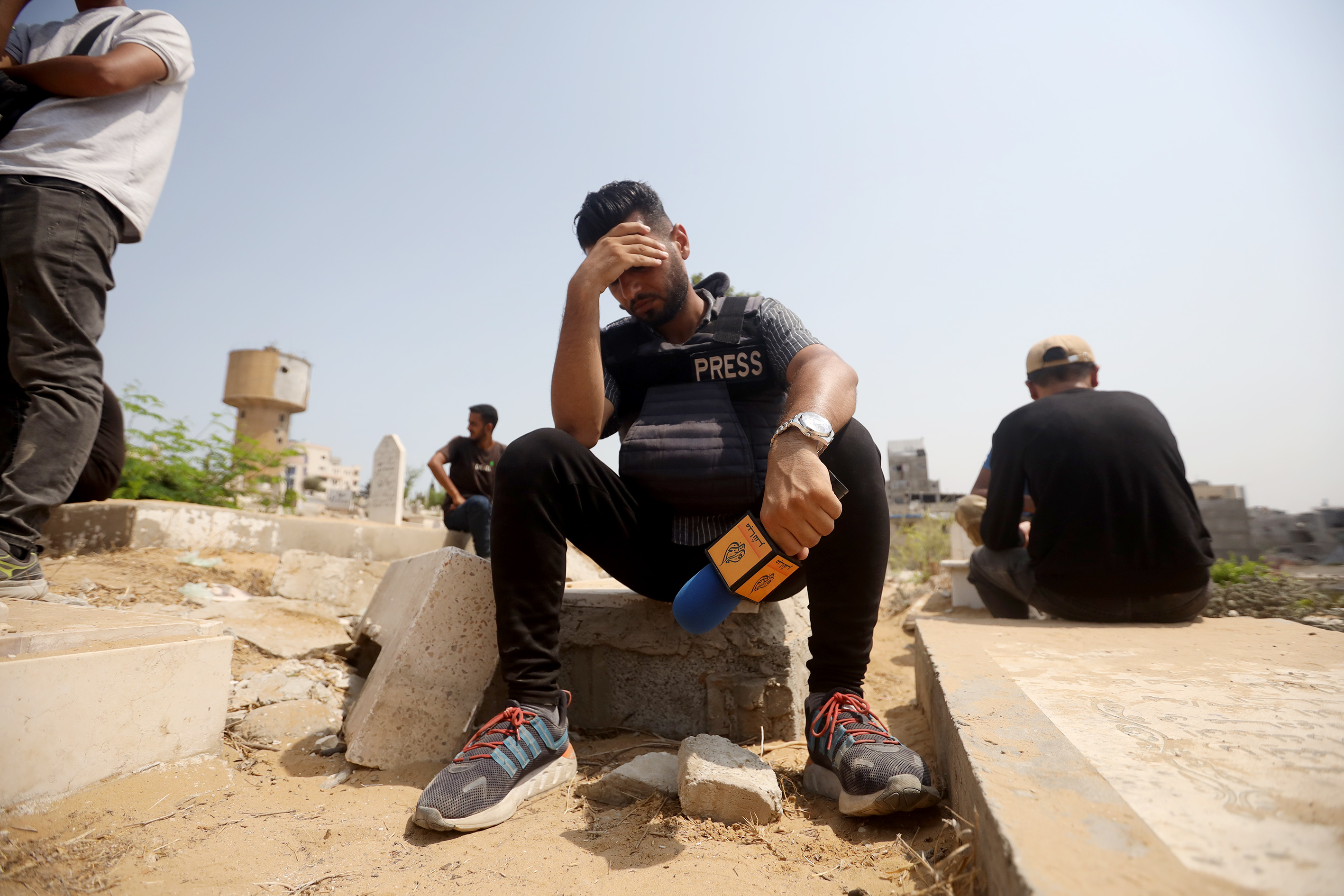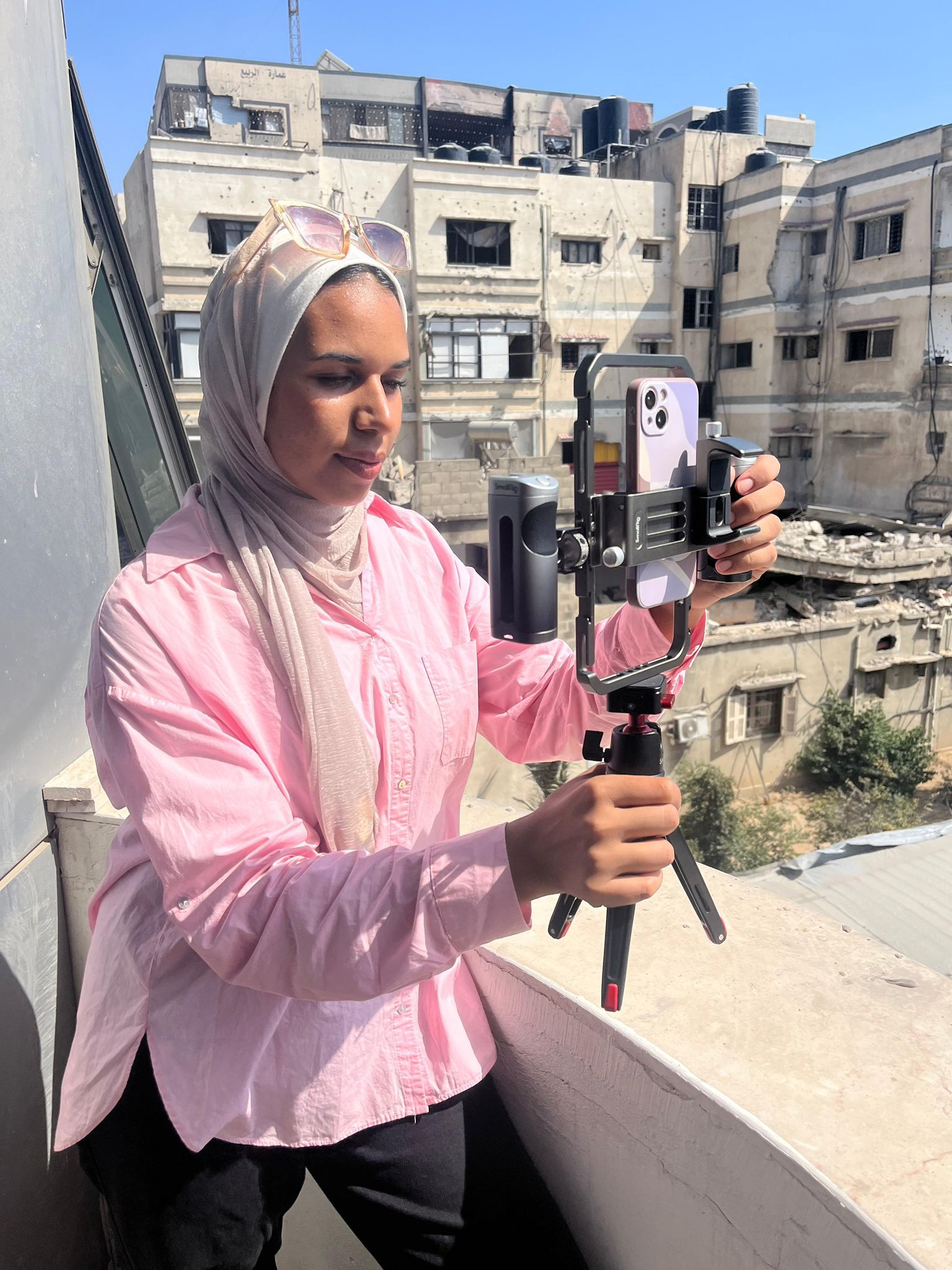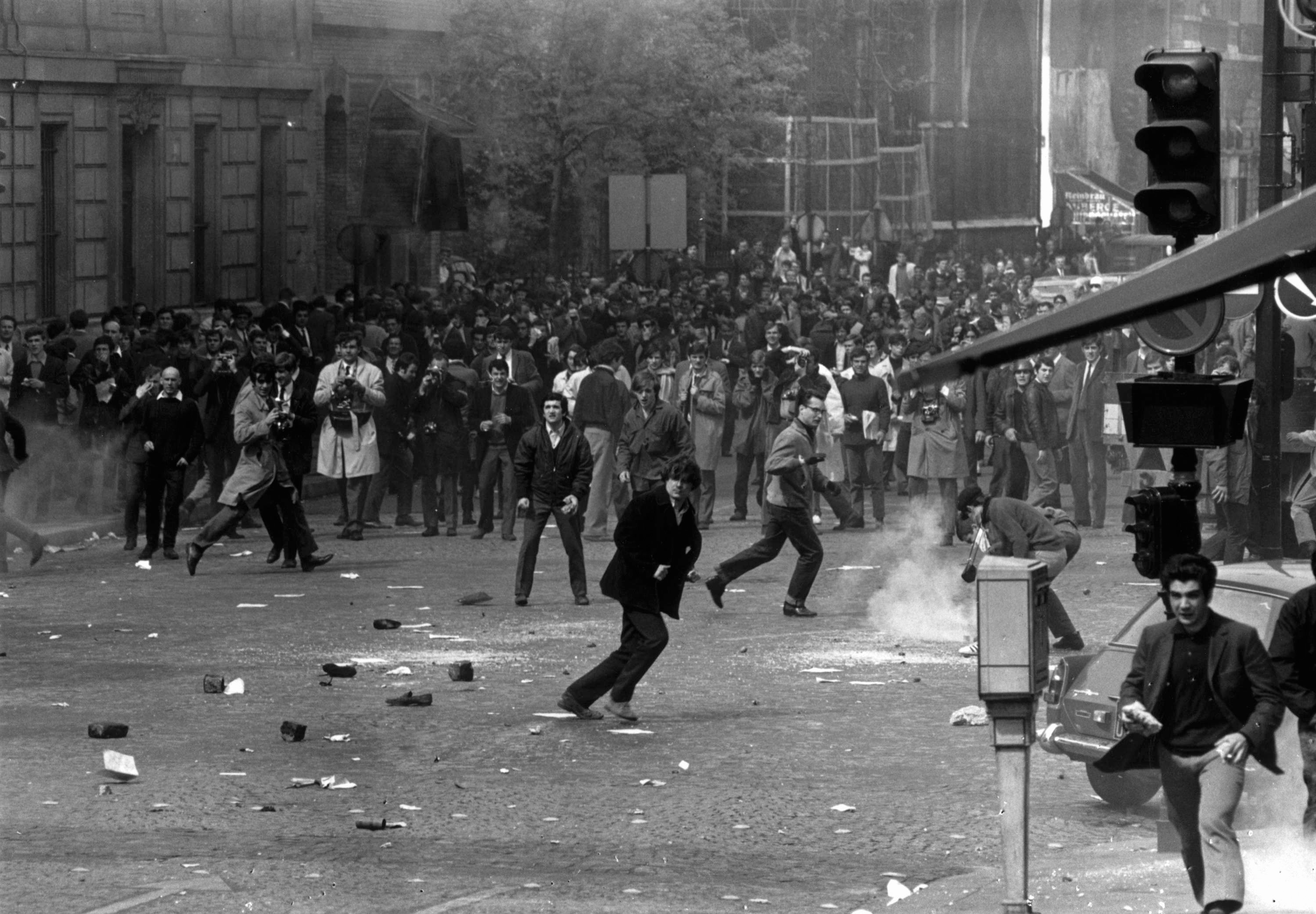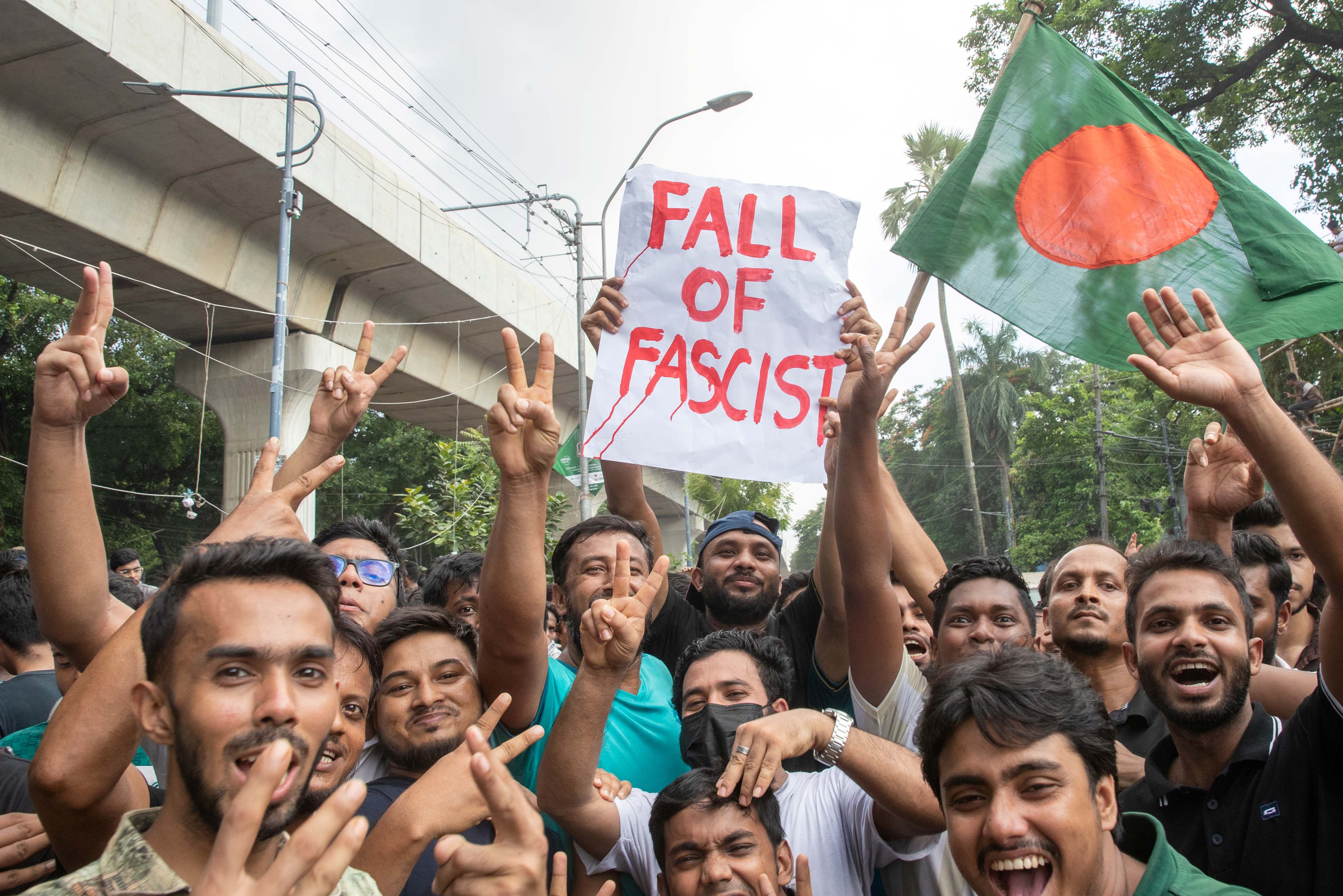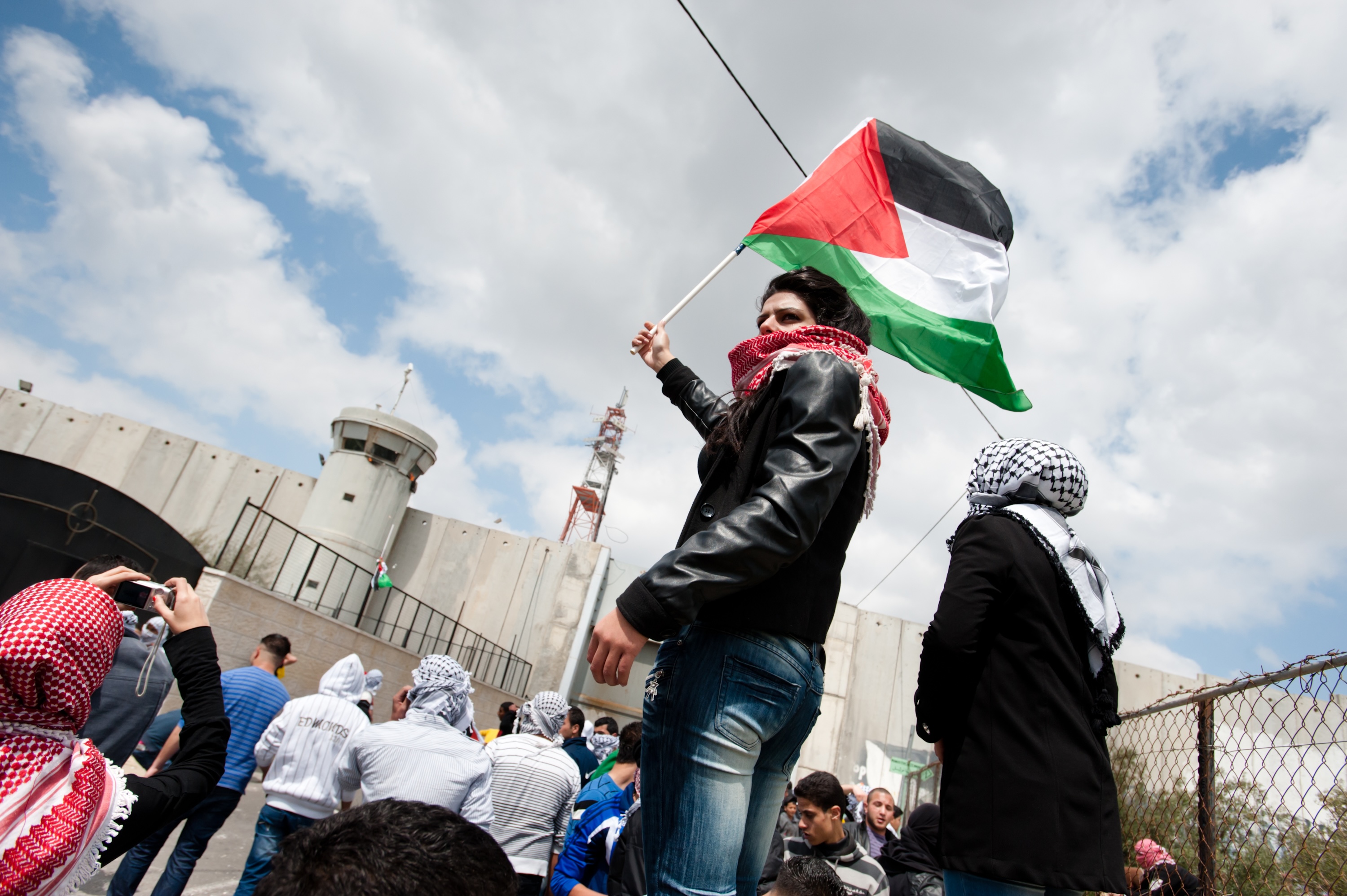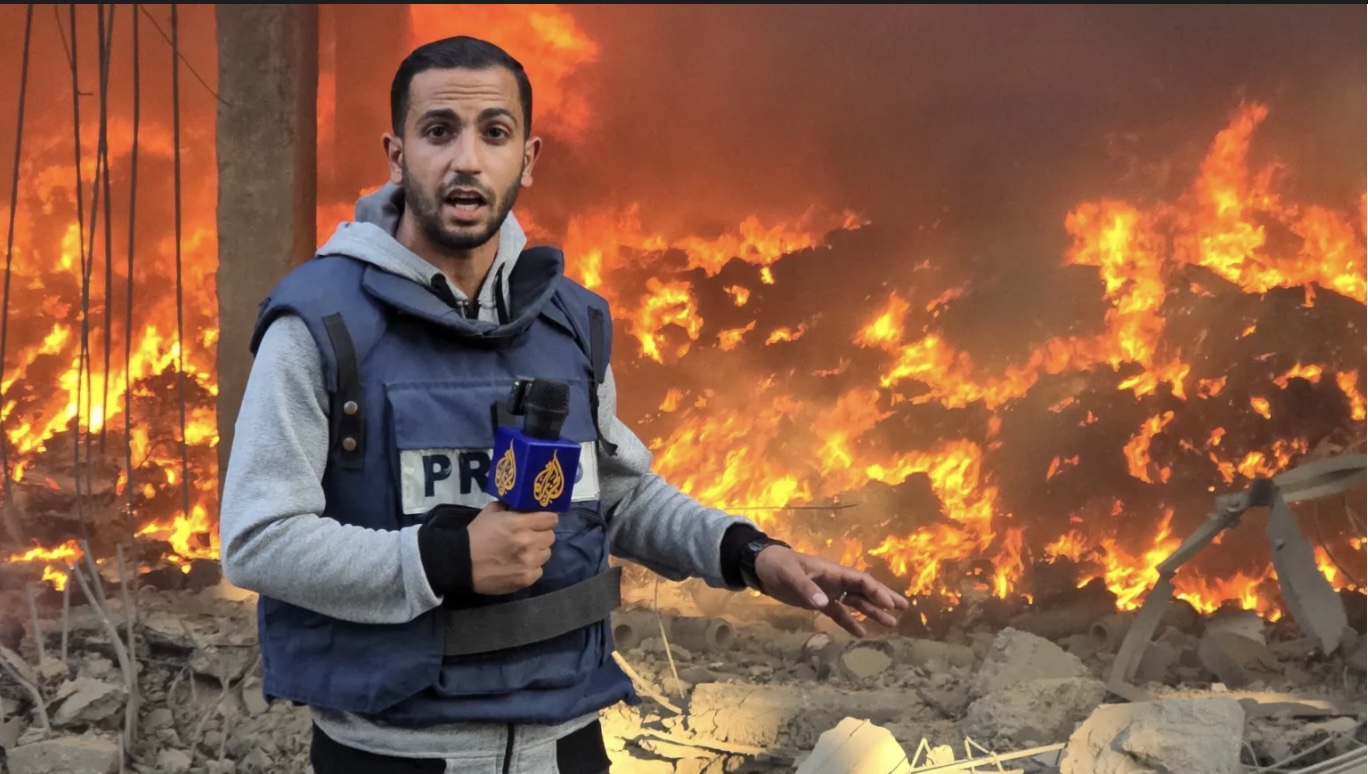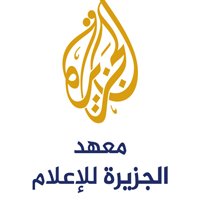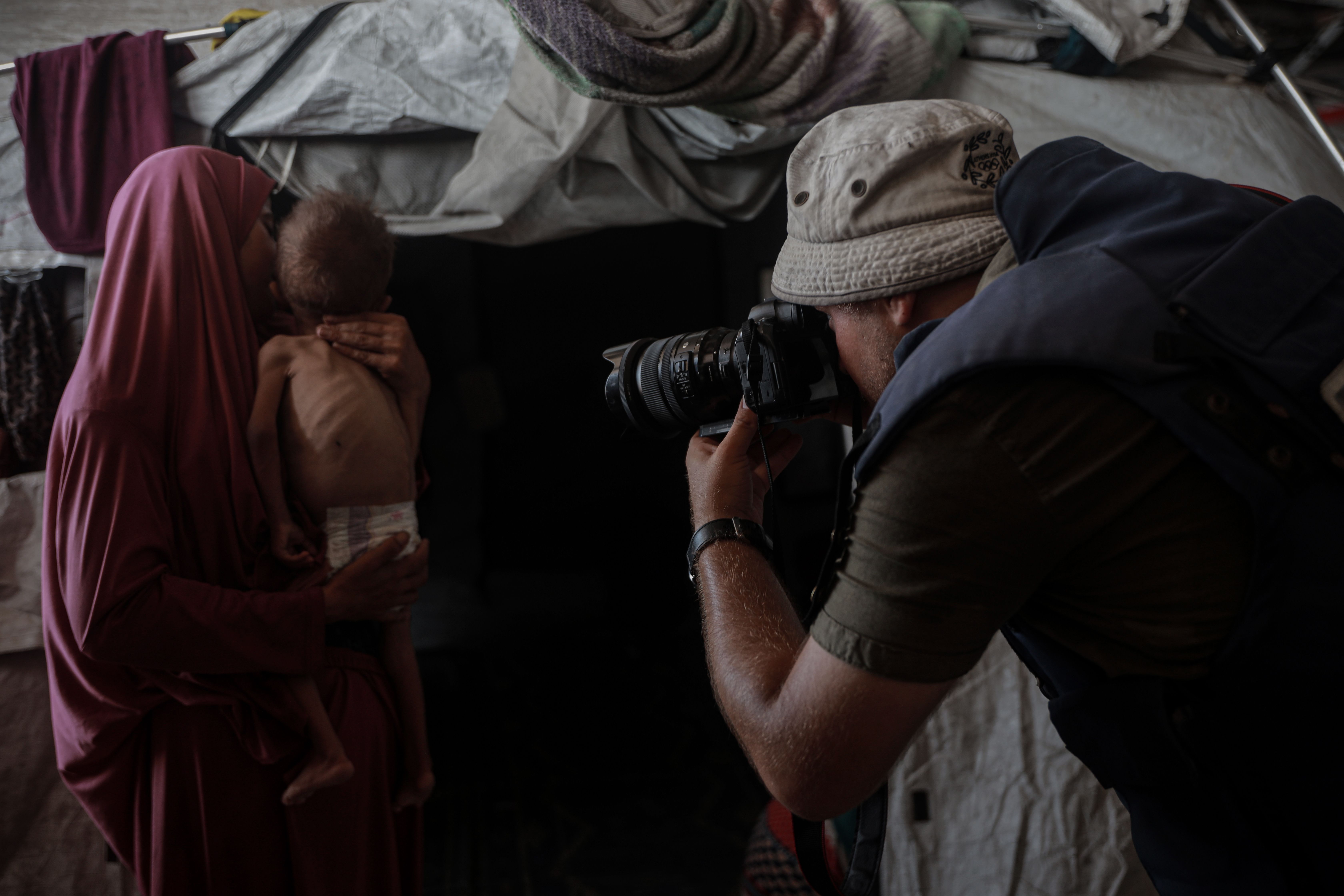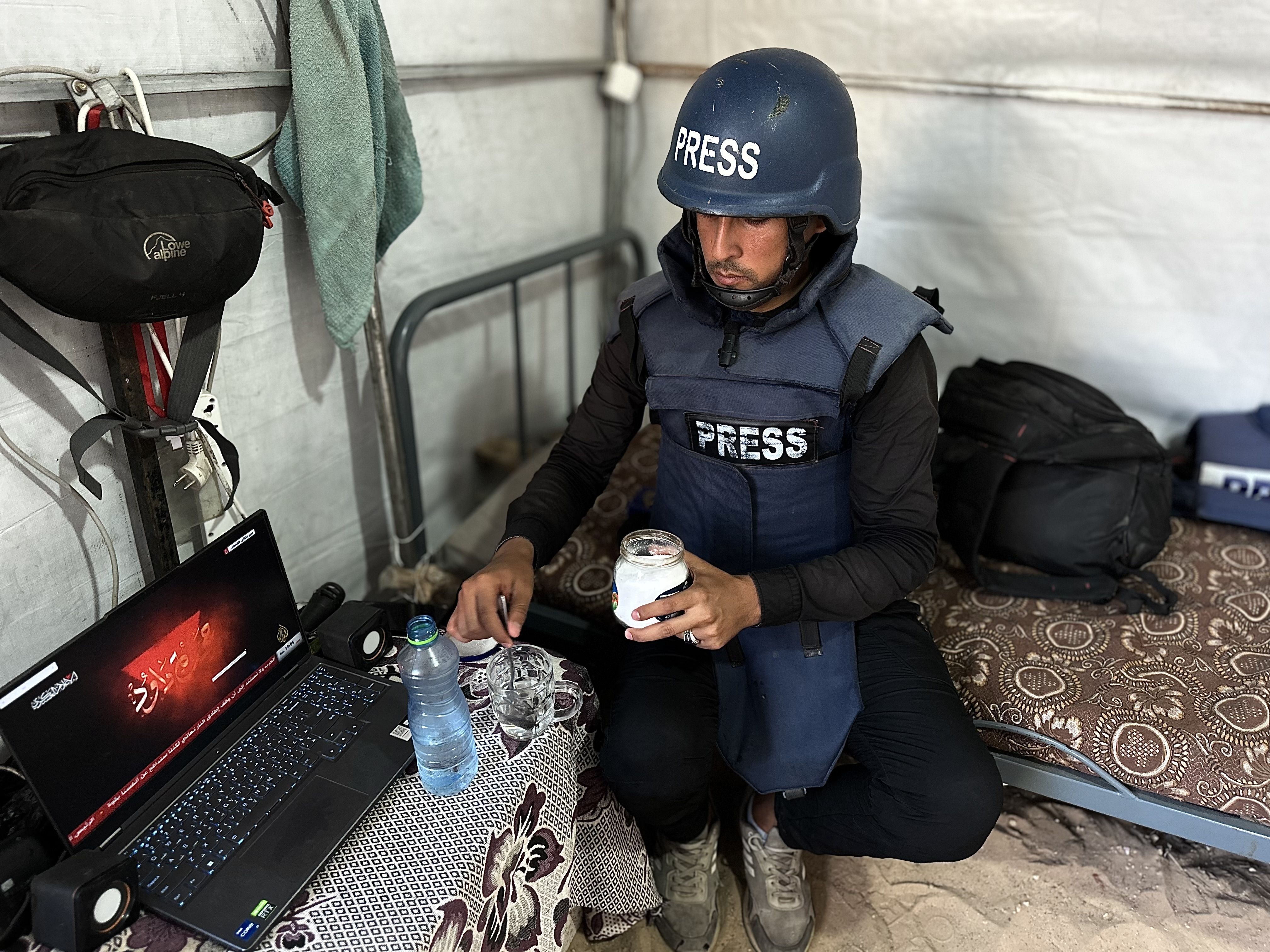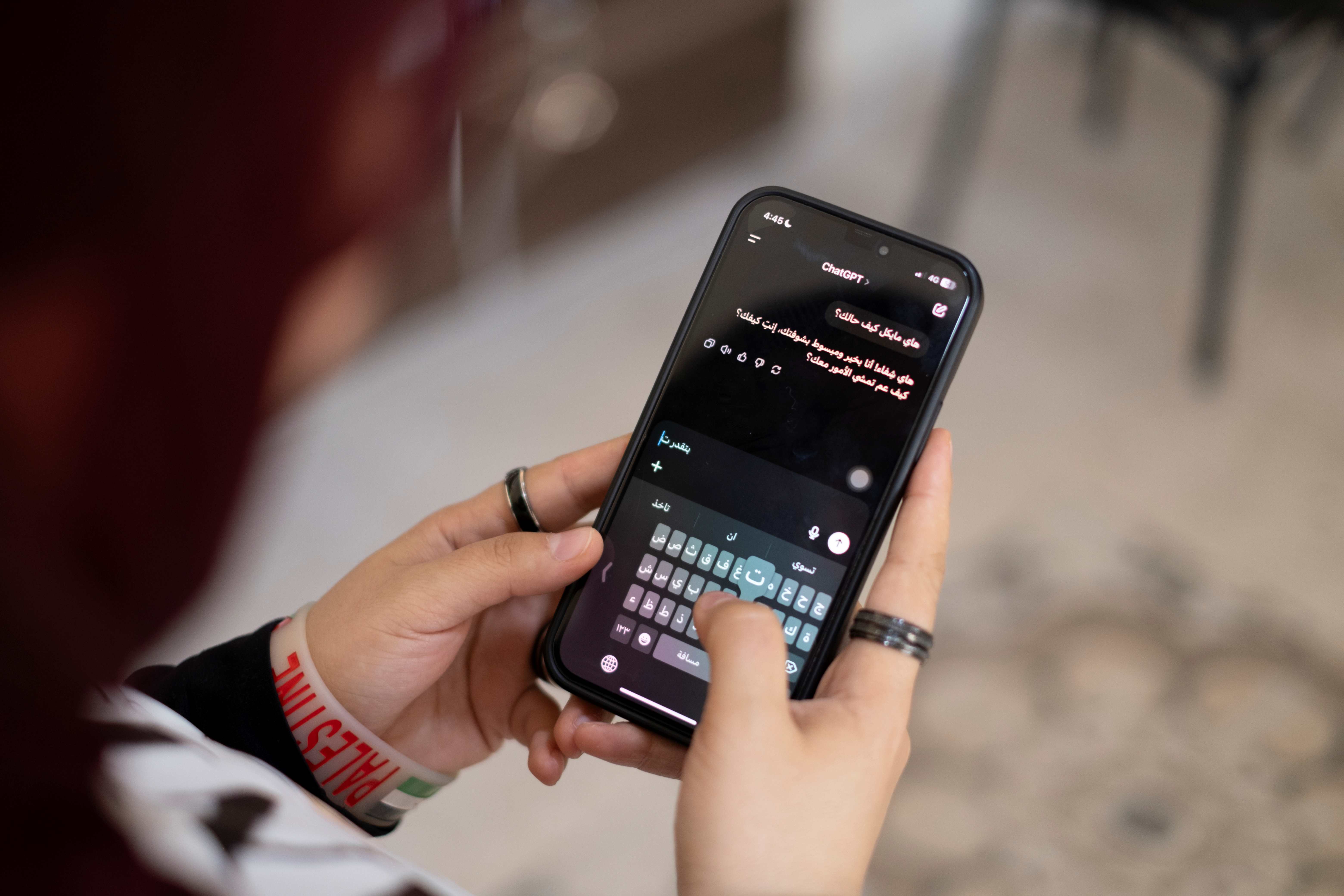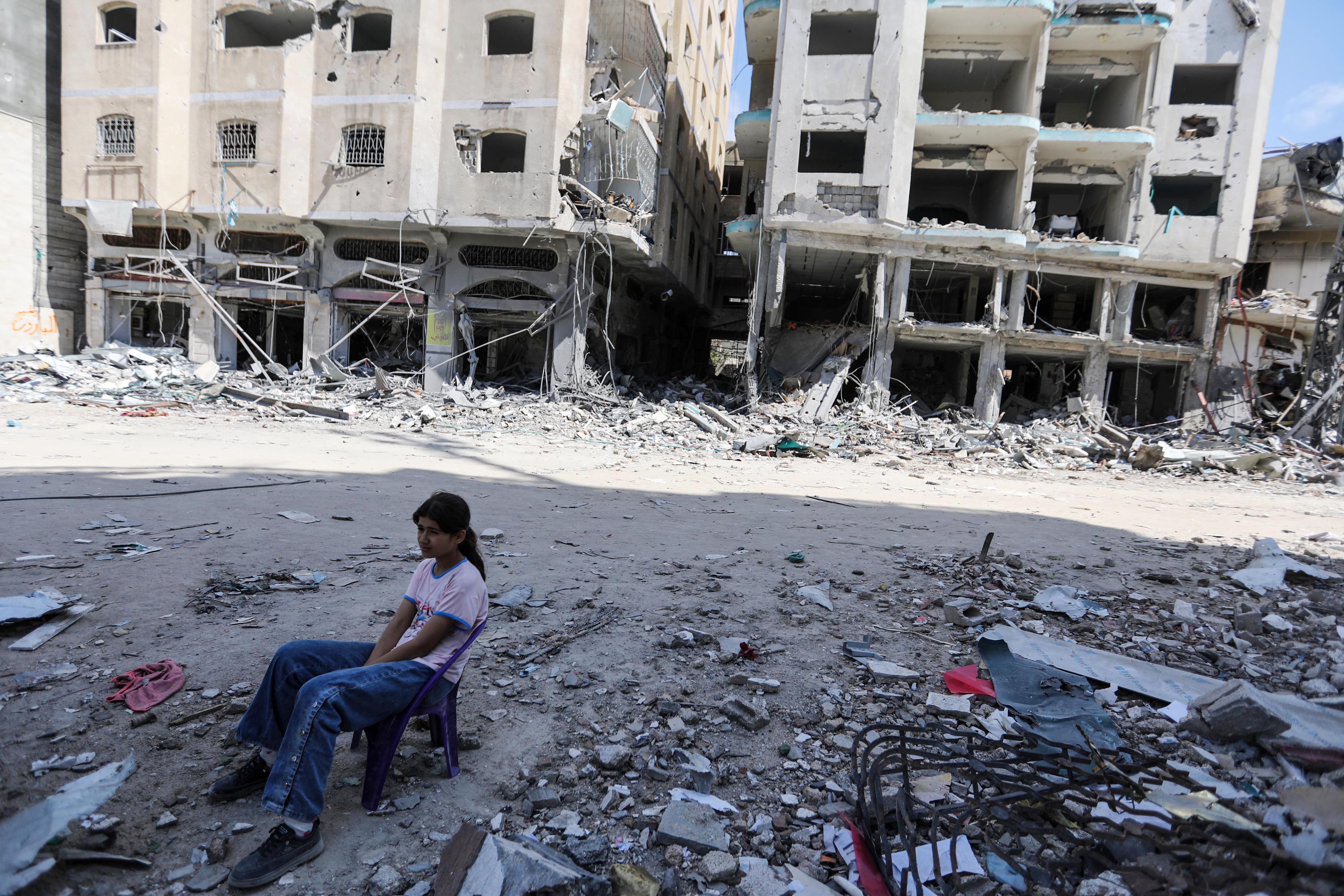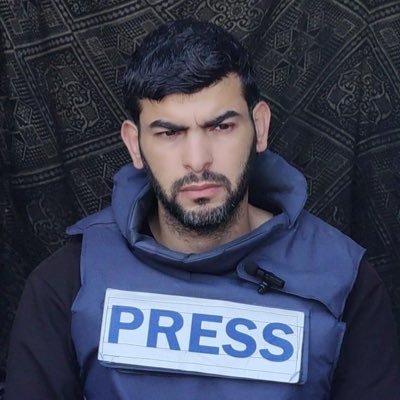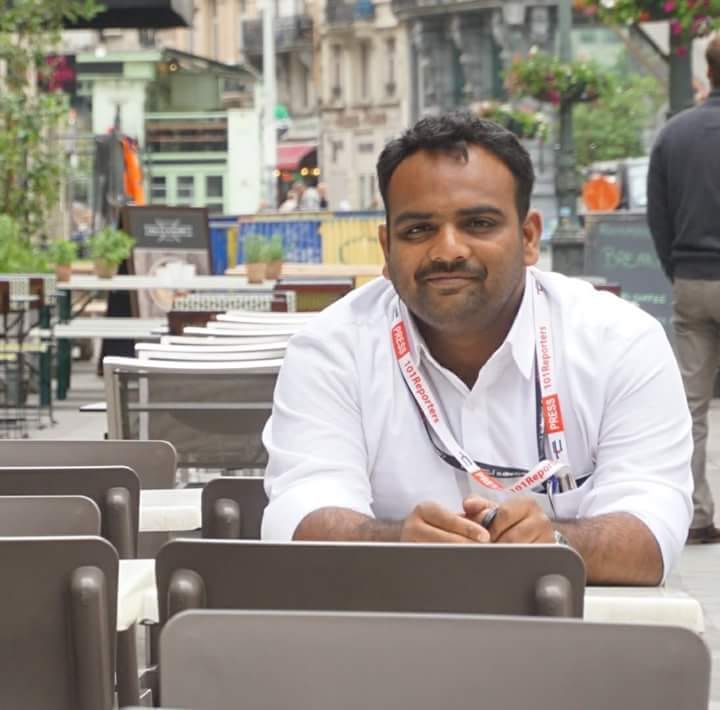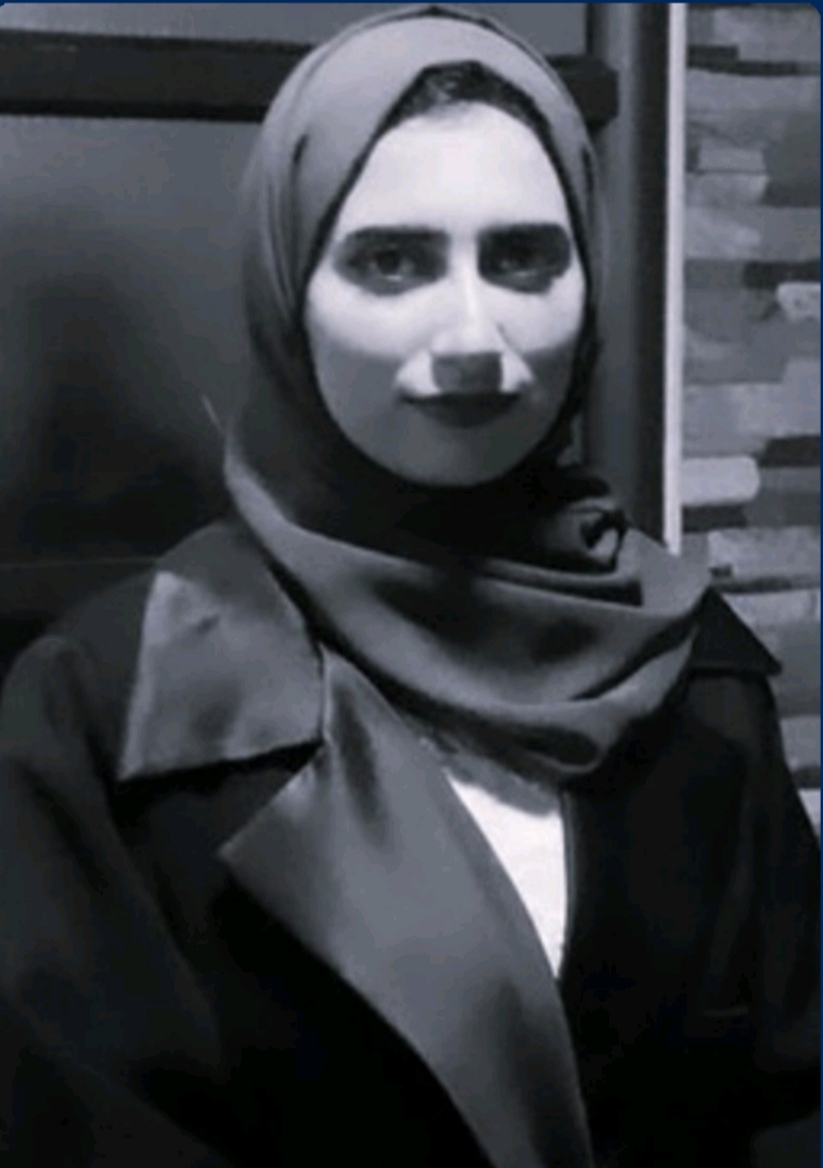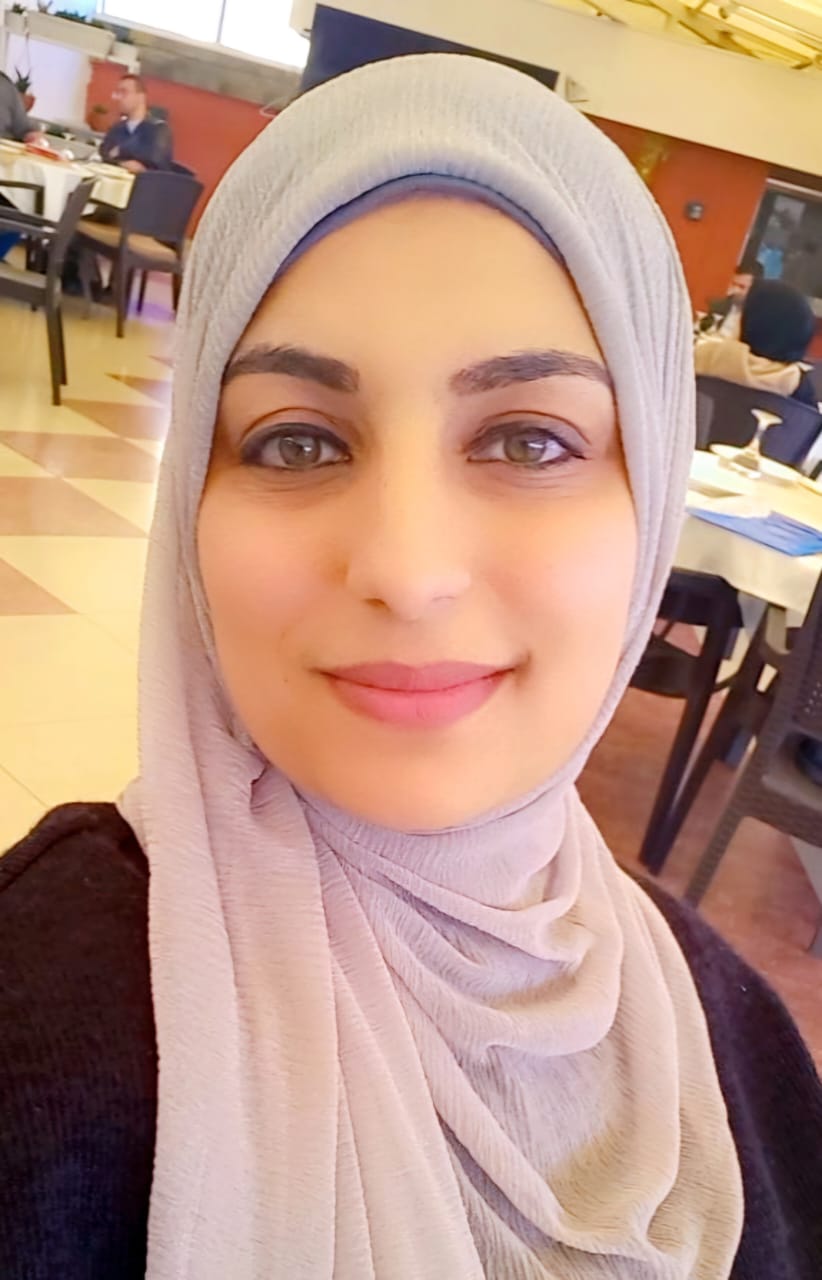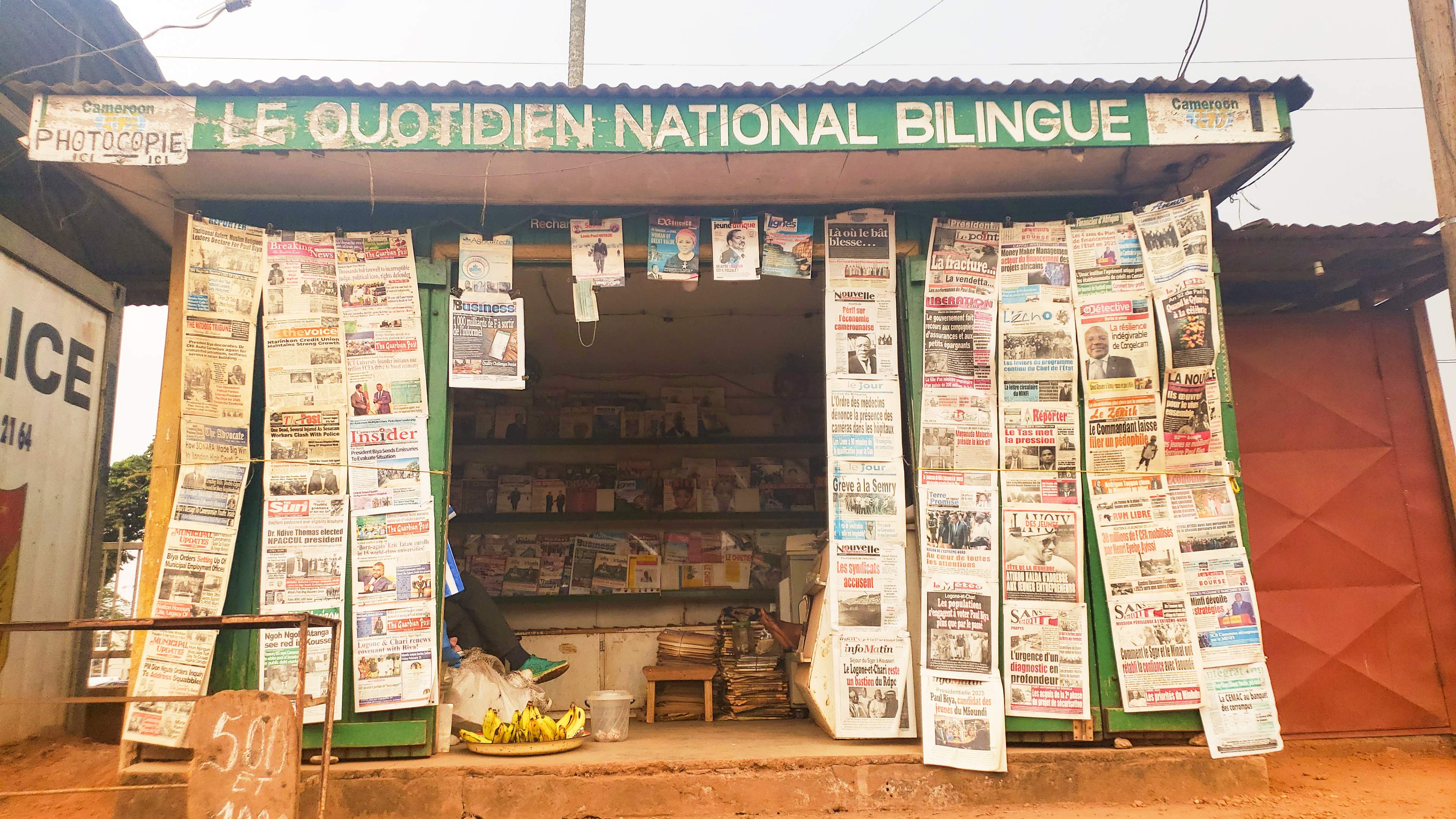|
عرض القسم الأول من الفصل العاشر من كتاب " التحقق في الصحافة الاستقصائية " لطريقة مجلة "دير شبيغل" في التحقق من المعلومات وتوثيقها وأرشفتها، ويقدّم القسم الثاني من الفصل بعض الحالات المتعلقة بالتحقق من الأخبار. |
دراسة الحالة 1:
البحث في 324000 كادر فيديو من هاتف محمول للمساعدة في إثبات براءة ناشط في ريوفيكتور ريبيرو ( Victor Ribeiro )، صانع أفلام وناشط وموسيقي مقيم في ريو دي جانيرو. وهو ما فتئ يعمل على مشاريع متعلقة بالتعليم وحقوق الإنسان منذ 2002 وله خبرة واسعة في استخدام أدوات الوسائط المتعددة في نشاطه، بالإضافة إلى الإشراف على ورش عمل وتقوية الشبكات المجتمعية المحيطة به. تعاون ريبيرو مع " WITNESS.org " في ريو منذ 2013. وقد ساهم سابقا في مشاريع مثل Radio Madame Sata و Rio Distipico و Laboratorio de Direitos Humanos de Manguinhos و Rio Toxico . (1)

يوم 15 أكتوبر/تشرين الأول 2013 اعتقل ناشط عمره 37 عاما يدعى يائير سيكساس ( Jair Seixas ) المعروف ببايانو، في نهاية احتجاج في ريو دي جانيرو لدعم المعلمين المضربين. سيكساس كان يمشي في المظاهرة بشكل سلمي مع ثمانية محامين حقوقيين عندما اقترب منه رجال شرطة واتهموه بإشعال النار في عربة شرطة وحافلة صغيرة.
وبينما كانوا يقتادونه بعيدا، رفضت الشرطة أن تقول للمحامين إلى أي قسم شرطة سيأخذونه أو ما هي أدلتهم على الجرائم المزعومة.
احتجز سيكساس في السجن 60 يوما ثم أطلق سراحه. فواصل في دفع التهم التي وجهت إليه. عندما بدأ محاموه في خطة الدفاع، بحثوا عن مقاطع فيديو قد تساعد في إثبات براءته. شملت عملية البحث شبكات التواصل الاجتماعي، وسأل محاموه من كانوا في تلك الفعالية، وحصلوا على مقاطع مصورة من الادعاء العام والمحاكم.
وجد المحامون خمسة مقاطع شعروا أن لها قيمة كأدلة. اثنان من مقاطع الفيديو كانا تسجيلات رسمية في المحكمة لأفراد من الشرطة يدلون بشهادتهم تحت القسم. مقطعان آخران كانا قد سلما للمحكمة من قبل الادعاء، وتم التأكد من أنهما صورا من قبل رجال شرطة متخفين اخترقوا المتظاهرين. المقطع الأخير صورّه أحد نشطاء الإعلام الذي كان يغطي المظاهرة وكان موجودا عند اعتقال سيكساس. استخدم هذا الناشط هاتفه المحمول لبث الحدث مباشرة مما وفر عددا كبيرا من المقاطع الهامة المصورة للواقعة.
عند ربط مقاطع الفيديو ببعضها البعض، وجد المحامون أدلة دامغة على براءة سيكساس. كانت الشهادات المصورة لأفراد الشرطة مليئة بالتناقضات وساعدت في إثبات أنهم لم يشاهدوا سيكساس بالفعل وهو يضرم النار في الحافلة، خلافا لما ادّعوه سابقا. فيديو الادعاء التقط صوت أفراد الشرطة السرية وهم يشجعون المتظاهرين على العنف. أظهر ذلك - في بعض الحالات - أن العنف الذي اتهم به متظاهرون مصدره رجال شرطة متخفين.
الفيديو الأخير الذي صوره ناشط إعلامي، كان دليلا حاسما: في تحليل كل "فريم" على حده لنحو ثلاث ساعات من مادة البث الحي التي تمت أرشفتها من الاحتجاج (324000 فريم) كشف فريق الدفاع أن "فريما" واحدا يظهر أن مركبة الشرطة التي اتهم سيكساس بإحراقها كانت ذاتها التي أركبوه بها عند اعتقاله. تم إثبات ذلك بمقارنة الصفات المُمَيِّزة للمركبة الظاهرة بالفيديو مع المركبة التي نقل بها سيكساس.
نحن في WITNESS ساعدنا الدفاع على تحضير مخطط صور متسلسل للأحداث إضافة إلى فيديو مدته عشر دقائق يسلم كدليل للقاضي إلى جانب بعض الوثائق.
ورغم أن القضية لا تزال مستمرة، إلا أن الأدلة واضحة ولا تقبل الشك. هذا مثال ملهم للدور الذي يمكن أن يلعبه مقطع فيديو، سواء من مصادر رسمية أو من مواطنين، في خدمة العدالة وحماية الأبرياء من الاتهامات الباطلة.
دراسة الحالة 2:
التحقق من دليل محوري في واقعة إطلاق النار في أوتوا (# OttawaShooting )
ميكا كلارك Micah Clark مدير المهام في مؤسسة SecDev وهي وكالة خاصة للاستخبارات وموفر للأمان الإنترنتي. في مركزه ووظيفته أشرف ميكا على مهام SecDev لفهم، وتوجيه، وتحليل أحداث أثناء تكشفها في أوتوا يوم 22 أكتوبر/ تشرين أول 2014. في الأيام العادية يدير ميكا فريقا من محللين، ومطوري برامج، ومصوري البيانات لإيصال منتجات تحليلية للحكومة ولزبائنه من الشركات في كندا والولايات المتحدة والمملكة المتحدة.
يقول المثل الروسي القديم "للخوف عيون كبيرة تتخيل وجود ما ليس موجود."
هذه القصة عن العيون الكبيرة للخوف والأشياء غير الموجودة.
في الساعة 9:50 صباحا تقريبا من يوم 22 أكتوبر/ تشرين أول 2013 أطلق ميشيل زيهاف بيبو Michael Zehaf-Bibeau النار على جندي يحرس النصب التذكاري للحرب في أوتوا وقتله. في مشهد يعيد إلى الأذهان أفلام التشويق الهوليودية انطلق زيهاف بيبو في قاعات البرلمان حيث تم في النهاية إطلاق النار عليه وقتله.
قبل يومين قتل جندي كندي عندما صدمته عمدا سيارة يقودها رجل كان قد سبق ولفت أنظار أجهزة الأمن الكندية. إطلاق النار المتبادل الذي تلى تلك الواقعة في بارليمنت هيل Parliament Hill أصاب الكنديين بالتوتر. هل هذا هجوم إرهابي؟ ما هو دافع المهاجم؟ هل تنظيم الدولة متورط في تلك الأحداث؟
وصلت التخمينات حداً كبيرا عندما تم نشر صورة للمهاجم على تويتر أخذت في لحظة الاعتداء تدعي انتماءه إلى تنظيم الدولة. سريعا ما تم استخدام الصورة في حسابات تويتر أخرى، ثم استخدمها أخيرا الصحفيون الكنديون، ثم الجمهور الكندي، ونشرها حساب تنظيم الدولة ليرسم صورة خيالية تماما تربط بين المهاجم والتنظيم.
ولكن كل هذا التخمين كان، مع ذلك، مبنيا على إحالة إلى مصدر غير صحيح أساسا. إن قصة مصدر الصورة الفعلية هي مثال ملفت إلى ما أصبح أمرا معتادا في الصحافة الحديثة.
تم نشر الصورة أولا من قبل مستخدم مجهول ردا على تغريدة لشرطة أوتوا تم فيها طلب أي معلومات عن المعتدي. حدث ذلك قبل الساعة الثانية عصرا عندما عثر الصحفي المقيم بمونتريال ويليام ريموند William Reymon على الصورة والتقط صورة للشاشة (ريموند الذي كتب كثيرا حول هذا السبق لم يوفر رابط للتغريدة من شرطة أوتوا. ولكن الوقت والمضمون الذي يصفه يشير إلى أنها كانت هذه التغريدة). الصورة والحساب الذي نشرها تم محوهما فورا تقريبا.
لإعطاء ريموند حقه فإنه قضي ساعتين كاملتين وفي حوزته هذه الصورة الاستثنائية، كي يتحقق منها قبل نشرها على حساب تويتر الخاص به @Breaking3zero عند الساعة 4:16 مساء.
العملية التي استغرقها ريموند في التحقق، والتي يصفها هنا بالتفاصيل، تتضمن مقارنة قسمات وجه، وملابس، وسلاح الرجل الذي يظهر في الصورة مع مشاهد كاميرا المراقبة، بالإضافة إلى مقارنتها مع تفاصيل ظهرت عندما تشارك شهود عيان ومسؤولين في تفاصيل الاعتداء.
بالإضافة إلى السلاح، كان هناك دليلان رئيسان هما: أن الرجل في الصورة يرتدي كوفية كما وصفها شهود، وأنه كان يستخدم مظلة لإخفاء سلاحه وهو يقترب من النصب التذكاري حسبما قالت التقارير.
هذا ما غرده ريموند:
بعد ساعتين من التحقق، أكد مصدر لي أنه "يشبه مطلق الرصاص" تعامل مع الأمر بحرص.
ولم ينشر الحساب المتصل بتنظيم الدولة على تويتر @ V_IMS Islamic Media )) الصورة إلا بعد تغريدة ريموند عند حوالي الساعة 4:45 مساء. وقد تم تعليق ومحو هذا الحساب أيضا.
كتب ريموند "بعد أن نشرتُ الصورةَ بعشرين دقيقة قام حساب باللغة الفرنسية يساند تنظيم الدولة بأخذ الصورة ثم نشرها... وبهذا بدأت بعض وسائل الإعلام في نشر الفكرة الخاطئة بأن التنظيم هو مصدر الصورة".
بعد دقائق قام حساب آخر على تويتر @ ArmedResearch بنشر الصورة قائلا إن حساب " ISIS Media # نشر الصورة مدعيا أنها لميشيل زيهاف- بيبو المتوفي والمشبته به في OttawaShooting # إطلاق نار أوتوا في # Canda ".
وبرغم الفشل في تأكيد ادعائه أو نسب الصورة إلى @ Breaking3zero بشكل مناسب، تشبث الصحفيون الكنديون بادعاء ArmedResearch @ ونقلوا في أخبارهم أن الصورة "تم تغريدها من حساب داعش"، بكل التبعات التي تلحق بمثل هذا التأكيد.
ولكن كما يقول المثل، فإن الحقائق أشياء عنيدة. فقد أظهرت البيانات التقنية من صفحة تويتر V_IMS @ والتي التقطت قبل تعليق الحساب @V_IMS أظهرت أنه حصل على الصورة من Breaking3zero @. النص باللون الرمادي بالأسفل يظهر رابط المصدر الأصلي منtwitter.com/Breaking3zero

ادعاء أن صورة زيهاف-بيبو أتت أصلا من حساب التنظيم هو ادعاء مزيف تماما. حساب تنظيم الدولة الذي نشر الصورة حصل عليها بعد نشرها لأول مرة على تويتر بساعات.
وتظهر مراقبة SecDev المستقلة لحسابات التواصل الاجتماعي لتنظيم الدولة أن حسابات بارزة للتنظيم كانت تتفاعل مع الأحداث في أوتوا بنفس الطريقة التي كان يتفاعل بها سكان أوتوا وآخرون - نشر معلومات متناقضة وأحيانا غير صحيحة عن الهجوم. لا توجد إشارة في مواقع التواصل الاجتماعي أن التنظيم كان لديه معرفة سابقة بالهجوم، أو أنه مرتبط بأي شكل بزيهاف-بيبو.
بل إنه لا توجد حتى الآن أدلة تشير إلى تورط التنظيم في هجوم أكتوبر في أوتوا. ولكن هناك صورة ملفتة تم التقاطها في لحظة استثنائية تشهد بقوة تكنولوجيا الهاتف المحمول والتواصل الاجتماعي القادرة على تغيير قواعد اللعبة.
هناك إغراء كبير جدا في أن نجد صلة بين الصور الواضحة مثل تلك الصورة وأسوأ مخاوفنا (بنسبها بتسرع لتنظيم الدولة). وتفادي هذا الإغراء هو أحد المسؤوليات الرئيسية للصحفيين في القرن الواحد والعشرين.
دراسة الحالة 3:
التحرك بين اللغات (والتهجئات) المختلفة للوصول لشركات في الشرق الأوسط
حمود المحمود Hamoud Almahmoud هو كبير باحثين ومدرب في مكتب أبحاث وبيانات الشرق الأوسط وشمال إفريقيا لمؤسسة إعلاميون من أجل صحافة استقصائية عربية أريج ARIJ Mena Research & Data Desk at the Arab Reporters for Investigative Journalism . هو أيضا باحث إقليمي في مشروع إعلام الجريمة المنظمة والفساد Organized Crime and Corruption Reporting Project (OCCRP ) وقد عمل محررا استقصائيا في الصحافة المطبوعة، والتلفزيون، ثم عمل رئيس تحرير مجلة الاقتصادي المتخصصة في الاقتصاد والإنترنت لعدة سنوات. يغرد على حسابه على تويتر بـ HamoudSy @.
البحث عن أسماء الشركات أو الأشخاص في الشرق الأوسط يقدم لنا بعض التحديات الخاصة. فلنبدأ بمثال حقيقي عملت عليه مؤخرا:
تلقيت مؤخرا طلبا من صحفي أوروبي يرغب في إجراء تحقيق عن شركة Josons التي فازت بمناقصة لتوريد أسلحة في أوروبا الشرقية.
كانت هذه الشركة مسجلة في لبنان. ولم يخرج الصحفي بأي نتائج عن الشركة وهو يبحث عن معلومات عن في السجل التجاري اللبناني على الإنترنت.
بدأت فورا في التفكير في كيفية كتابة اسم هذه الشركة بالعربية وخاصة باللهجة اللبنانية. بالطبع كنت أعرف مسبقا أن اسم هذه الشركة لا بد أنه مذكور في سجل الشركات اللبنانية على الإنترنت باللغة الإنجليزية. ولكن محرك بحث السجل التجاري اللبناني أظهر نتائج محدودة وبالعربية فقط. لهذا لم يحظ الصحفي بنتائج.
على سبيل المثال فإن البحث عن " Josons " في السجل التجاري الرسمي يعطينا النتائج التالية:

كما نرى فالنتائج (0) ولكن يجب أن لا نيأس ونتوقف عن المحاولة. أول خطوة هي تخمين كيف تكتب Josons بالعريبة. من الممكن أن يكون هناك عدد من التهجئات المحتملة. في البداية، بحثت في غوغل عن كلمة "لبنان" بالعربية بجوار اسم الشركة بالإنجليزية: لبنان: Josons . أظهرت أول صفحة من النتائج أن اسم الشركة بالعربية جوسانز كما هي في السجل الرسمي:
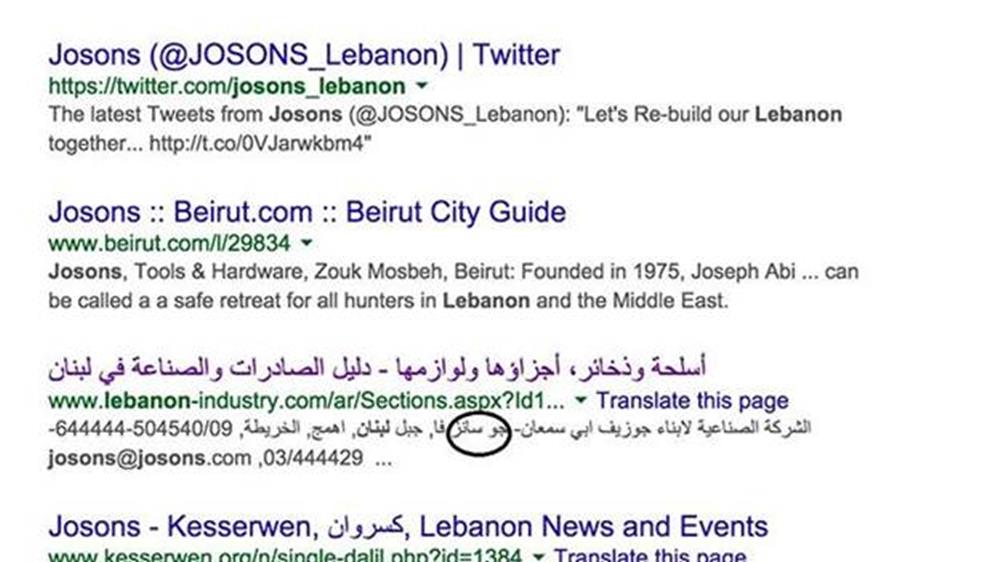
تم تأكيد ذلك أيضا بالبحث في السجل التجاري اللبناني على الإنترنت
لدينا الآن اسم الشركة بالعربية. البحث باسم جوسانز في السجل التجاري أظهر أن الشركة مسجلة مرتين. مرة داخل البلاد ومرة في خارج لبنان.
ثقافات الكتابة
كان ذلك مثال على كيفية التعامل مع تحديات اللغة عند جمع معلومات عن الشركات في منطقة الشرق الأوسط وشمال إفريقيا. إنجاز هذا العمل كثيرا ما يتطلب العمل باللغات العربية والفرنسية والإنجليزية والكردية بالإضافة إلى لهجات عربية عديدة.
الخطوة الأولى هي تحديد ما هي اللغة التي سيتم البحث بها عن المعلومات التي تحتاجها ثم معرفة طريقة التهجئة بالعربية. مع ذلك تذكر أن نطق كلمة واحدة قد يتغير بشكل كبير بين الدول المتحدثة بالعربية.
على سبيل المثال، للبحث عن شركة قابضة، من المفيد أن نعرف كيف نكتب كلمة " group " في قاعدة البيانات العربية للسجلات التجارية. ولكن هناك ثلاث طرق لكتابة الكلمة بناء على كيفية نقل الكلمة الإنجليزية " group " إلى الحروف العربية (لا يوجد حرف عربي مقابل للصوت " p ")
1. في السجل التجاري الأردني على سبيل المثال تكتب جروب.

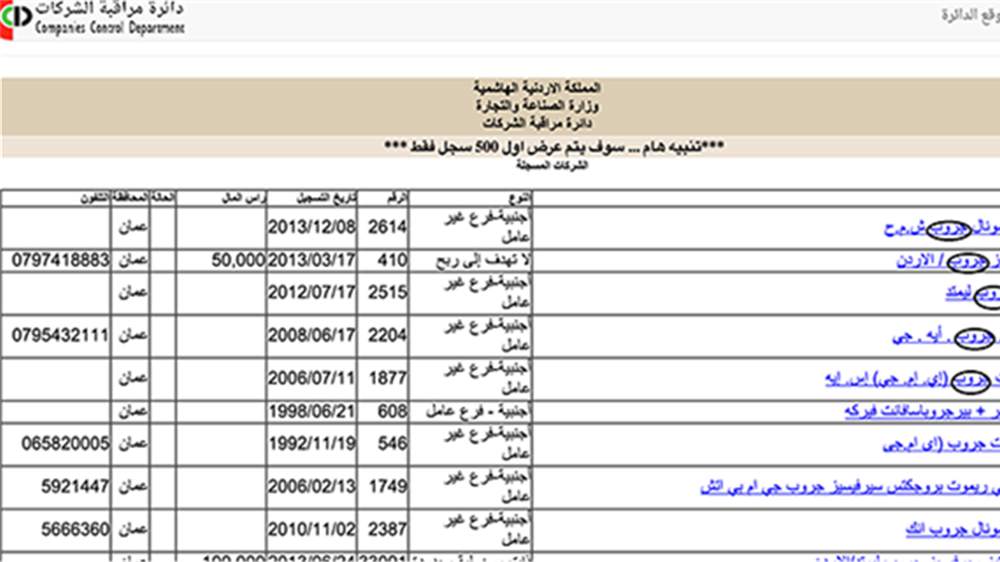
2. في لبنان: غروب.
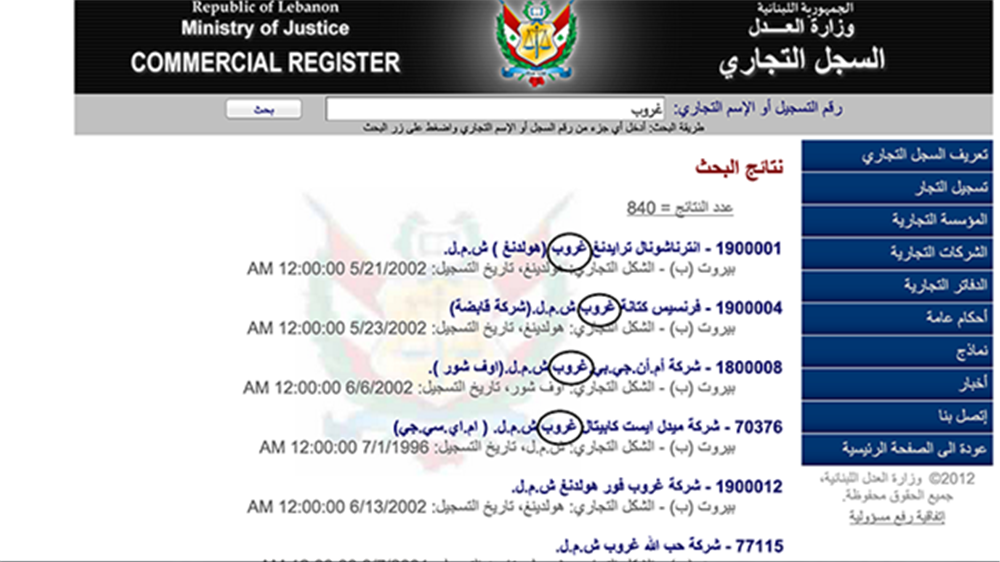
3. التهجئة الثالثة كما تظهر في السجل التجاري التونسي هي قروب.
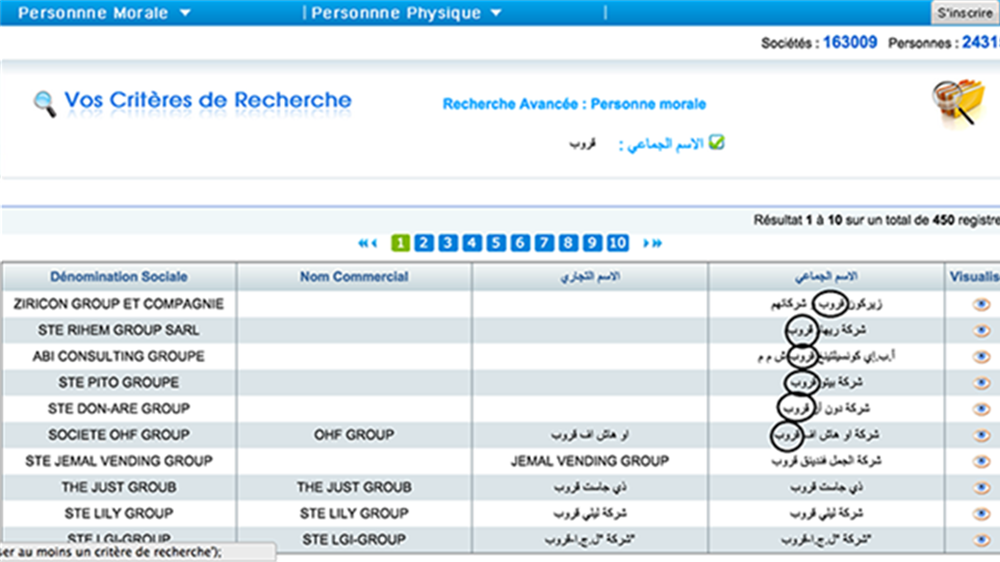
انتبه أيضا إلى أنك يجب أن تبحث باستخدام تهجئات مختلفة لنفس الكلمة داخل نفس السجل الواحد. فعلى سبيل المثال، كلمة " global " يمكن أن تكتب غلوبال أو غلوبل. ويمكنك أن تجد التهجئتين في السجل التجاري البحريني.
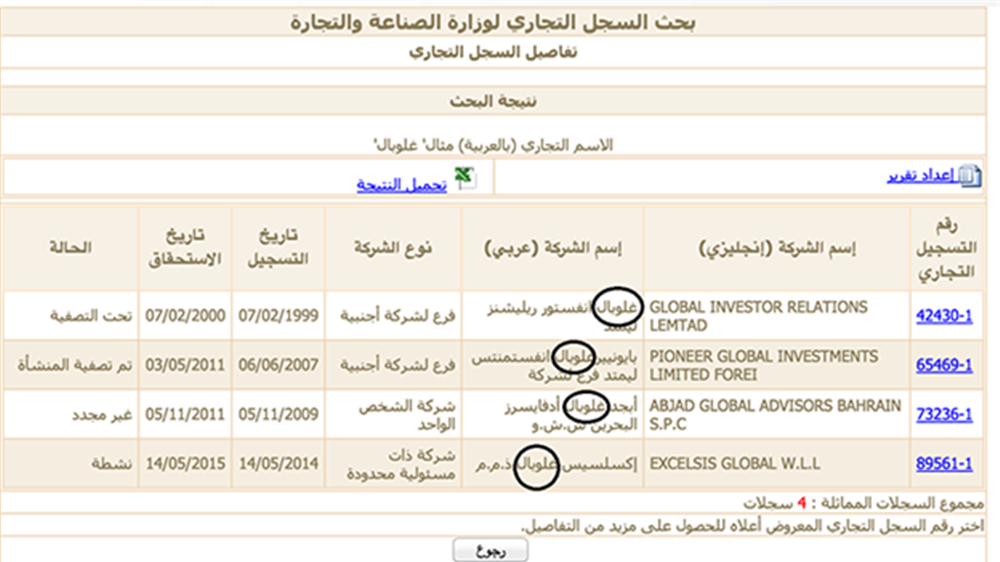
تبين هذه الأمثلة كيف أن فهم الثقافة واللغات وعوامل أخرى يمكن أن تلعب دورا في التأكد من قدرتك على استخدام البيانات العامة والمعلومات استخداما فعالا خلال البحث.
هامش
(1) الروابط التالية تتضمن بعض أعمال ريوفيكتور ريبيرو: http://rio40caos.tk
http://labdhm.blogspot.com.br/
هذا التقرير مأخوذ من كتاب "دليل التحقق للصحافة الاستقصائية" الذي ترجمه معهد الجزيرة للإعلام بالتعاون مع مركز الصحافة الأوروبي. للاطلاع على الكتاب كاملا الرجاء الضغط على الرابط أدناه.
http://verificationhandbook.com/book2_ar/handbook2.arabic.pdf


